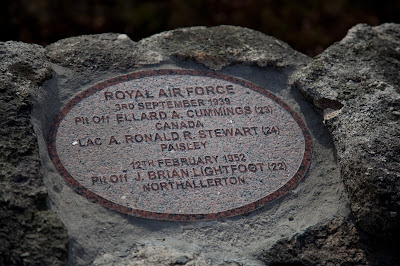Bennachie’s Casualties of War - By Duncan Harley
September 3 marks the anniversary of the declaration
of war in 1939 and, just a few hours into the conflict, the
Bennachie hill-range in Aberdeenshire was witness to an accident resulting in
the deaths of two RAF airmen.
The hill has seen two 20th century air
crashes. The most recent in 1952 when an RAF Gloster Meteor jet fighter on a
training flight from RAF Leuchars crashed during a snowstorm into Oxen Craig on
12 February 1952. The pilot, Yorkshireman Brian Lightfoot died instantly on
impact and wreckage was scattered over a wide area. One of the aircraft’s
cannon was retrieved by souvenir hunters and was for a time stashed in a barn
over at Oyne before being re-discovered in the 1980’s.
The RAF’s fleet of Gloster Meteors had what can only be described as a horrendous safety record and records indicate that there were 436 fatal accidents between 1944 and 1986. Some 890 of these aeroplanes were lost during that period over the entire UK including one piloted by the son of the headmaster of Oyne Primary school. Local writer James Mackay records in a 2012 article in Leopard Magazine that “In the early 1950’s fifty Meteor pilots died when their planes dived inexplicably into the ground” and that in 1952 “ a Meteor was written off every two days on average and a Meteor pilot was killed every four days.”
'The lesser known 1939 air crash on the hill came to prominence in September
2012 when a commemorative cairn was unveiled near the peak of Oxen Craig to
commemorate the Meteor pilot along with the crew of an RAF Westland Wallace
biplane which had crashed on nearby Bruntwood Tap on 3 September 1939. The RAF’s fleet of Gloster Meteors had what can only be described as a horrendous safety record and records indicate that there were 436 fatal accidents between 1944 and 1986. Some 890 of these aeroplanes were lost during that period over the entire UK including one piloted by the son of the headmaster of Oyne Primary school. Local writer James Mackay records in a 2012 article in Leopard Magazine that “In the early 1950’s fifty Meteor pilots died when their planes dived inexplicably into the ground” and that in 1952 “ a Meteor was written off every two days on average and a Meteor pilot was killed every four days.”
Around 80 folk attended the ceremony, including relatives from both Yorkshire and Canada. As local Air Cadets formed an honour guard, an RAF Padre led the service of remembrance and the relatives were guided to the respective crash sites to pay their respects.
The Westland Wallace biplane was equipped to operate as an air-target tug and had been on its way from the Air Observers School at RAF Wigton to an airfield in Easter Ross. On the Dyce to Easter Ross leg of the flight the pilot had obviously misjudged his height and, in thick mist, had failed to clear the peak.
Both crew, air-gunner Alexander Stewart from Paisley and Canadian pilot Ellard Cummings, were found by the search parties still strapped into the cockpit leading to speculation that PO Cummings had stalled the plane in the midst of an effort to pull up at the very last moment. The tail-plane was broken off indicating that the rear of the aeroplane had probably struck the ground first. Both fliers were thought to have died instantly, probably from broken necks and debris from the crash is still visible on the hillside.
In the 1960’s walkers on the lower portion of the hill often passed by the rusting nine-cylinder engine from the Westland Wallace wreck which had been rolled down the slopes of the hill by souvenir hunters. When a local firm of timber contractors removed it to their premises over at Tillyfourie intending to sell it for scrap, the RAF got involved and re-took possession of the artefact with the intention of restoring it for display at the RAF Museum at Cosford.
The Wallace aircrew were of course taken off the hill for burial. The Canadian pilot, PO Cummings, is buried in the Grove Cemetery in Aberdeen and gunner Alexander Stewart was interred at Hawkhead Cemetery in his native Paisley.
A ‘Find-a-Grave’ record relating to PO Cummings reads: “Ellard was one of the first casualties of WWII, having been killed on the day Great Britain declared war on Germany. He was a Canadian national serving with British forces, namely the Royal Air Force in which he held the rank of Pilot Officer (Pilot) Service No: 40803. He was 23 and the son of James Victor and Edith Fanny Ellard Cummings of Ottawa, Ontario, Canada. Westland Wallace K6028 of 1 AOS, on a ferry flight to 9 AOS flew into hills in bad visibility at Bennachie, near Aberdeen two members of the crew being killed.”
James Mackay records in his Leopard Magazine article that Alexander’s father visited the crash site quite soon after the tragic event. He is said to have removed a small section of the aircraft’s wooden propeller intending to carve a two scale models of the Westland Wallace airplane in memory of the airmen who are to this day officially recorded as being the very first UK military casualties of the Second World War.'
The above extract is from my book: ‘The Little History of Aberdeenshire’.
Duncan Harley is author of ‘The
A-Z of Curious Aberdeenshire’
Published by The History Press.
ISBN 9780750983792
Content and images © Duncan Harley
Published by The History Press.
ISBN 9780750983792
Content and images © Duncan Harley











Comments
Post a Comment